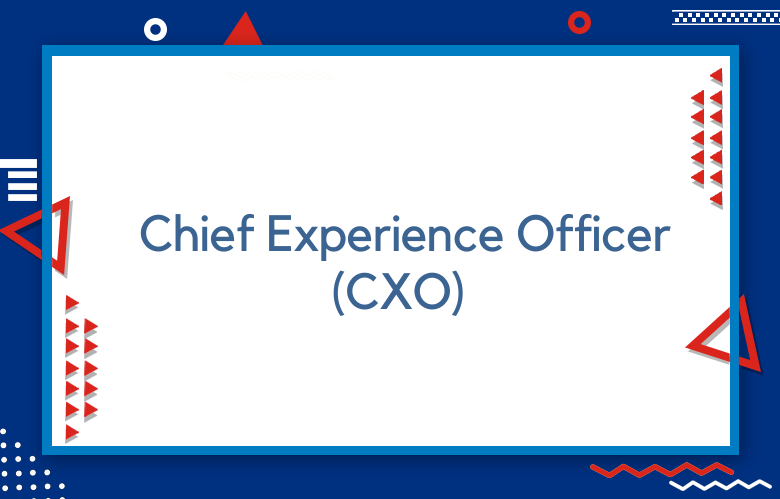Chief Experience Officer (CXO) Role and Responsibilities

The Chief Experience Officer (CXO) is a strategic executive-level role focusing on creating and enhancing the customer experience across all touchpoints. The CXO ensures that the organization’s products, services, and interactions are designed to deliver a superior customer experience.
Chief Experience Officer (CXO) Role and Responsibilities
The Chief Experience Officer (CXO) is a strategic executive-level role focusing on creating and enhancing the customer experience across all touchpoints. The CXO’s primary responsibility is to ensure that the customer experience is a top priority for the organization and that it is integrated into all aspects of the business.
This position has become increasingly important as organizations recognize the critical role that customer experience plays in driving customer loyalty, retention, and overall business success.
The CXO’s responsibilities typically include:
It develops and executes the organization’s customer experience strategy, including defining the vision, goals, and initiatives to improve customer experience.
We are identifying opportunities to enhance customer experience across all touchpoints, including product and service design, marketing, sales, customer service, and support.
We lead cross-functional teams to execute customer experience initiatives, including project management, resource allocation, and stakeholder management.
We monitor and analyze customer experience metrics to assess the effectiveness of customer experience initiatives and inform strategic decisions.
Collaborating with other leaders within the organization to ensure alignment of customer experience initiatives with overall business objectives.
Fostering a customer-centric culture within the organization, including developing customer experience skills and capabilities among employees, creating a customer-first mindset, and promoting customer experience best practices.
Building partnerships with key stakeholders, including customers, suppliers, and partners, ensures the organization’s customer experience strategy aligns with their needs and expectations.
Communicating the organization’s customer experience vision and strategy to key stakeholders, including the board of directors, investors, employees, and customers.
Leading the organization’s customer experience team, including product managers, designers, researchers, marketers, and customer service professionals, to ensure that the customer experience strategy is executed effectively across all departments.
Identifying and championing new technologies and innovations can enhance the customer experience and drive business growth.
Overall, the CXO plays a critical role in today’s customer-centric business landscape. They are responsible for ensuring that the organization delivers a superior customer experience that drives loyalty, retention, and overall business success. The CXO must have a deep understanding of customer experience best practices, strong leadership skills, and the ability to drive organizational change and innovation.
The Rise of the CXO: Understanding the Chief Experience Officer’s Role and Responsibilities
In recent years, the Chief Experience Officer (CXO) role has gained significant prominence as organizations increasingly recognize the importance of delivering exceptional customer experiences. The CXO is a strategic executive-level role that focuses on creating and enhancing the customer experience across all touchpoints, from product and service design to customer service and support.
As businesses increasingly shift their focus from products and services to experiences, the CXO has emerged as critical in driving business success. According to a report by PwC, 86% of buyers are willing to pay more for a better customer experience, and 89% of businesses expect to compete mainly based on customer experience in the next three years.
In this article, we will explore the role and responsibilities of the CXO and how they can help organizations deliver exceptional customer experiences that drive business growth and success.
Unleashing the Customer-Centric Vision: Exploring the CXO’s Role and Responsibilities
The Chief Experience Officer (CXO) is a relatively new executive-level role that has emerged recently as organizations increasingly recognize the importance of delivering exceptional customer experiences. The CXO is responsible for developing and executing the organization’s customer experience strategy, ensuring that the customer experience is at the heart of everything the organization does.
In this article, we will explore the rise of the CXO, the role and responsibilities of this crucial position, and how organizations can benefit from investing in the CXO role to unleash their customer-centric vision.
The Rise of the CXO
As organizations recognize the critical importance of the customer experience in driving customer loyalty, retention, and overall business success, the CXO role has emerged as a key leadership position. The CXO ensures customer experience is a top priority across all organizational departments and functions, from product development and marketing to sales and customer service.
Understanding the CXO Role and Responsibilities
The CXO’s responsibilities typically include developing, developing, executing, and defining the organization’s customer experience strategy, including defining the vision, goals, and initiatives to drive customer experience improvements.
Identifying opportunities for customer experience enhancement across all touchpoints, including product and service design, marketing, sales, customer service, and support.
Leading cross-functional teams to execute customer experience initiatives, including project management, resource allocation, and stakeholder management.
Monitoring and analyzing customer experience metrics to assess the effectiveness of customer experience initiatives and inform strategic decisions.
Collaborating with other leaders within the organization to ensure alignment of customer experience initiatives with overall business objectives, I am fostering a customer-centric culture within the organization, including developing customer experience skills and capabilities among employees, creating a customer-first mindset, and promoting customer experience best practices.
Building partnerships with key stakeholders, including customers, suppliers, and partners, ensures the organization’s customer experience strategy aligns with their needs and expectations.
Communicating the organization’s customer experience vision and strategy to key stakeholders, including the board of directors, investors, employees, and customers.
It leads the organization’s customer experience team, including product managers, designers, researchers, marketers, and customer service professionals, to ensure the customer experience strategy is executed effectively across all its identities.
Identifying and championing new technologies and innovations can enhance the customer experience and drive business growth.
Unleashing the Customer-Centric Vision
By investing in the CXO role and prioritizing the customer experience, organizations can differentiate themselves in the marketplace, build strong customer relationships, and drive long-term business success. The CXO is a crucial asset for organizations looking to stay ahead of the competition and deliver exceptional customer experiences.
Behind the Scenes: The Secret Superpowers of a Chief Experience Officer
The Chief Experience Officer (CXO) is a strategic executive-level role focusing on creating and enhancing the customer experience across all touchpoints. While the responsibilities of the CXO are well-known, there are also several lesser-known but equally essential superpowers that the CXO possesses. This article will explore some of these secret superpowers that set the CXO apart and make them an invaluable asset to any organization.
The Power of Empathy
The CXO must deeply understand the customer’s needs, pain points, and desires. This requires empathy, the ability to understand and share another person’s feelings. Empathy allows the CXO to put themselves in customers’ shoes and design experiences tailored to their unique needs and preferences.
The Power of Innovation
The CXO must think outside the box and devise new and innovative ways to enhance the customer experience. This requires creativity, the ability to generate new ideas and solutions, and the willingness to take risks and try new things. Innovation is the key to staying ahead of the competition and delivering experiences that exceed customer expectations.
The Power of Influence
The CXO must inspire and influence others to support and execute their vision for the customer experience. This requires excellent communication and leadership skills and building relationships and coalitions across the organization. Influence is the key to driving change, and ensuring a good customer experience is a top priority for everyone in the organization.
The Power of Analysis
The CXO must be able to analyze data and insights to inform their decisions and strategies. This requires analytical skills, the ability to collect, analyze, and interpret data, and the ability to identify trends and patterns that can inform the design of better customer experiences. Analysis is the key to making data-driven decisions and measuring the impact of customer experience initiatives.
The Power of Adaptability
The CXO must be flexible and adaptable, able to pivot and change course to meet changing customer needs and market conditions. This requires agility, the ability to move quickly and decisively in response to new information or changing circumstances. Adaptability is the key to staying relevant and responsive in today’s fast-paced and ever-changing business environment.
Conclusion
The Chief Experience Officer (CXO) is a strategic executive-level role focusing on creating and enhancing the customer experience across all touchpoints. The CXO’s responsibilities include developing and executing the organization’s customer experience strategy, identifying opportunities for customer experience enhancement, leading cross-functional teams, monitoring and analyzing customer experience metrics, fostering a customer-centric culture, building partnerships with key stakeholders, communicating the customer experience vision and strategy, leading the customer experience team, and identifying and championing new technologies and innovations.
The CXO plays a critical role in today’s customer-centric business landscape. They are responsible for ensuring that the organization delivers a superior customer experience that drives loyalty, retention, and overall business success. The CXO must have a deep understanding of customer experience best practices, strong leadership skills, and the ability to drive organizational change and innovation.



